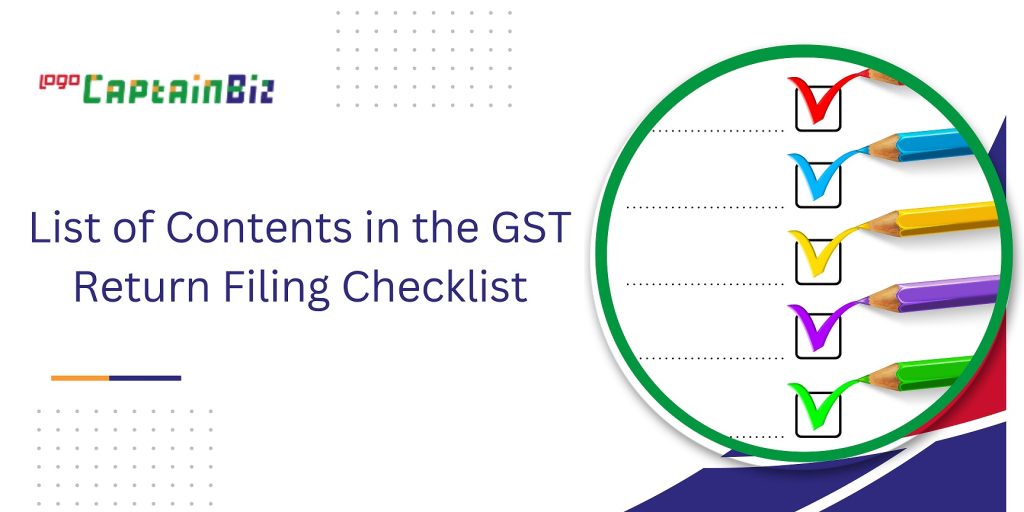Introduction
Every business must comply with the Goods and Services Tax obligations at the end of a financial year. However, the entire GST system is complex and involves many rules and regulations. You must follow a last-minute and comprehensive checklist to file everything according to the latest compliance without any flaws.
GST Checklist Requirements
Before you start with the GST audit procedure, you should understand the audit concept and the checklist of GST compliance related to it.
GST Audit as per the Turnover
If the aggregate annual turnover of a taxpayer exceeds Rs.5 crore, he should conduct a GST audit as per his turnover. For this, the taxpayer must engage a Cost Accountant or a Chartered Accountant for the audit based on yearly turnover.
Alternatively, the taxpayer should produce a statement of self-certified reconciliation to reconcile his value of supplies highlighted in the GSTR-9 annual return furnished for the present financial year. Also, he should provide an audited yearly financial statement for every financial year to file the online form GSTR 9C.
General GST Audit
A general GST audit becomes essential when any GST Commissioner undertakes the audit process with notice via form GST ADT-01. It informs the taxpayer within 15 working days of the audit process. An SGST Commissioner, CGST Commissioner, or an authorized person appointed by a GST Commissioner has the right to conduct the general GST audit.
Special GST Audit
An Assistant or a Deputy Commissioner initiates the special GST audit based on previous approval from the GST Commissioner. In this situation, the GST Commissioner appoints a professional Chartered Accountant to conduct the special GST audit.
Also Read: Serenity & Comprehensive GST Audit
Documents Required for GST Audit Checklist
Taxpayers must possess the following documents to initiate the process of GST audit-
- Profit and Loss statements and Balance Sheets for the taxpayers’ accounts with their respective schedules
- Inward and/or outward supply of various goods and services
- Trial balance according to any relevant GST number (GSTIN)
- Paid and payable output tax
- Breakdown of the collected Input Tax Credit, entry-wise or invoice-wise bill
- Various forms of GST returns
- Form 3CA, form 3CD, and other related reports on income tax audits
- Statutory auditor’s report
- Report of cost audit if it is applicable
Note-
A taxpayer is bound to provide a few additional documents for his GST audit based on his specific business type and nature.
Also Read: Audit And Documentation Requirements For GSTR-10
List of Contents in the GST Return Filing Checklist

GST Reconciliations between Your Tax Return Forms
Outward Supplies Data in GST Return Books Vs Account Books
- You should compare the data of outward supplies in your account books and the GST returns, like GSTR-1, GSTR-3B, and other GST return books. Doing so will let you recognize the possible changes in your GST returns. Make sure to include taxes and turnover in the differentiation.
- You should identify the differences based on settlements done on books’ documented rates, GSTR-1 reported rates, counting of tax ledgers, and 3B for your reverse charge mechanism.
- Besides, you should consider a few additional discrepancies, like excess or missed claimed input tax credit and monthly entry mistakes. For this, you must compare your credit balance with the GST portal cash and the balance highlighted in your books.
Invoice-level ITC register and GSTR-2B Differentiation
- Create an invoice-level differentiation between your ITC register book and GSTR-2B book. Here, the invoice comparison tracks both ineligible and eligible ITCs.
- To coordinate with each other with the ITC highlighted in GSTR-3b for the present fiscal year. The study may even track any overflow in your transactions.
RCM Paid vs RCM ITC Claimed
Verify if your paid RCM and claimed RCM associated with the input tax credit are in line but do not include ineligible ITC to identify discrepancies.
HSN Value Vs Books Value
Compare the value in your account books with the combined HSN value in GSTR-1 to identify any discrepancies.
GST e-way bill Settlement
You should make sure to settle your GST e-way bill with your GSTR-1 to fulfill the requirement of your e-way bill for any supply.
Inventory in Books Vs Physical Inventory
Compare the inventory mentioned in your account books with the physical inventory. This comparison may help you to ensure the ITC reversal requirement by identifying the missed ITC or lapsed account. Also, inventory comparison lets you prepare for GSTR9 and GSTR 9c for the current fiscal year.
Also read: What is the GST Return Filing Summary?
GST Returns for Input Tax Credit
Validation of ITC for Every Entry
You should validate to exchange the input tax credits for every entry related to asset and inventory write-offs, theft, destruction, samples, and obsolete items.
Original Tax Invoice
Every taxpayer must claim his input tax credit according to the received original tax invoice.
Goods/Services Receipt
You should verify to claim your input tax credit once you receive the goods or services. Moreover, if you receive goods in batches, you should confirm to claim your input tax credit only after you get the final lot of the supplied goods.
ITC Eligibility
Taxpayers must validate their claimed input tax credit eligibility. Simultaneously, one should check every transaction, where he has not availed of any input tax credit.
ITC Verification in GSTR-3B and GSTR-2A
Your claimed input tax credit amount must be accurate in the entry of GSTR-3B. Also, you must verify the match between your purchase register and GSTR-2A.
Inputs in Supplies
Make sure to check for every input you use for exempted and taxable supplies.
ITC Reversal is Essential
You must ensure the reversal of input tax credit according to the necessary provisions of the GST law.
ITC Accuracy for Diverse Categories
You should confirm to account for your input tax credit accurately under diverse categories. These include input services/inputs, import of goods and services, and capital goods in the accounts’ books.
ITC Reversal Process
Taxpayers must check and confirm the process followed while reversing the input tax credit while selling the capital goods before their asset life is over.
ITC for Tax Invoices
You must identify the invoices, which remain unpaid for about 180 days. In the case of an unpaid invoice, pay its interest immediately to reverse your input tax credit. Besides, one should verify that his debit/credit notes and invoices received from other suppliers comply with the GST law provisions.
GSTIN Accuracy is Essential
You should also confirm to fill the GSTIN accurately on your supplier’s tax invoice while claiming for input tax credit.
Credits for ITC
You should identify any credit that is categorized under blocked input tax credit. Simultaneously, if you claim any transitional credit as per the GST TRAN-1/2, you must make sure to complete its assessment.
ITC on the Purchase of Capital Goods
Taxpayers should essentially compute the depreciation cost at the time of availing ITC on the purchases of capital goods.
ITC from the Taxpayer’s Transition
You should check whether there is any input tax credit claimed in a transition to a regular one from a composition taxpayer.
Outward Suppliers GST Liability
GST Debit/Credit Note
Taxpayers must generate every GST credit or debit note for every excess or short value applicable or when the consumer does any sales return. Especially, you should focus on your agreement clauses related to discounts and other requirements for the issue of credit notes.
GST Provisions for Plant & Machinery
You should strictly adhere to the GST provisions associated with the sale or transfer of Plant and Machinery. Here, you must also consider the valuable check for party-related transactions.
Liability Ledger Online Comparison
You should examine the usage of tax entries in your accounts’ books by comparing them with the liability ledger available online.
GSTR-1 Examination and the Respective Changes
You should properly examine everything to change anything required in GSTR-1. Such amendments may be related to outward supplies from the tax type, B2B, or B2C. If you need to give credit to your clients, just do so within the specified deadline.
You should provide a strong mandate by highlighting the amendments, which are non-acceptable before the end of a financial year. Your tax liability must be equal to the advances received for services and adapt to collect unadjusted advances. Furthermore, you should cross-check differences between the involved parties and individuals to supply any regular service.
GST Sources and GST e-invoices
Check your income from different sources to identify the tax applicable under the GST. You should clear your tax position. GST sources include your GST interest on the late payment receipts and any recently clarified discounting vs incentive. However, employee recoveries are not categorized as payable taxes. Other than that, you should accommodate any GST online invoice generated in a year with the corresponding tax invoice.
Reverse Charge Mechanism for GST Returns
Reverse Charge Tax Payments
Taxpayers must verify to pay their reverse charge taxes according to the latest CGST Act. Simultaneously, they should confirm whether they have paid taxes under reverse charge for any notified supply.
Payments’ Accuracy and ITC Claims
You should check and make sure of the accuracy of your made payments for every reverse charge transaction you accomplish. Also, ensure to claim your income tax credit for any reverse charge payment only when it is eligible.
Payment Vouchers and Other Conditions
You should check to issue payment vouchers for your reverse charge payments. Once you are done, you must verify to make sure of fulfilling every condition for the reverse charge mechanism.
Conclusion
The GST audit procedure is a crucial compliance aspect for every company or business in India. A responsible taxpayer should make sure of the proper order of his financial records to comply strictly with the GST laws and regulations for the year. Here, taxpayers should refer to a well-prepared GST audit checklist. The checklist works as a roadmap to guide businesses through diverse requirements, procedures, and documentation involved in any GST audit.
Frequently Asked Questions
-
How can I file my GST returns for the year/month?
Every GST-registered business owner/taxpayer should file his GST returns online on the Returns section of the official GST website.
-
In what interval/frequency one should file the GST returns?
Every registered business venture should file its returns yearly, quarterly, or monthly. However, the GST returns’ frequency/interval depends solely on the type of business activity.
-
What refers to a compliance report in the Goods and Services Tax?
A compliance audit report involves verifying that you have accounted for the GST properly in your business transactions. Simultaneously, compliance ensures that you have reported every piece of information correctly in the GST returns.
